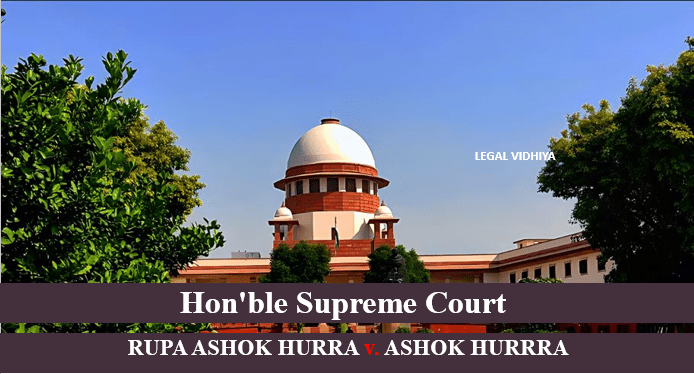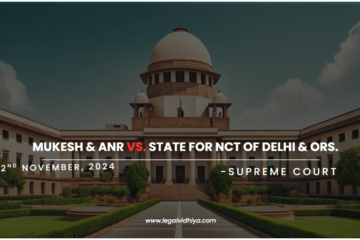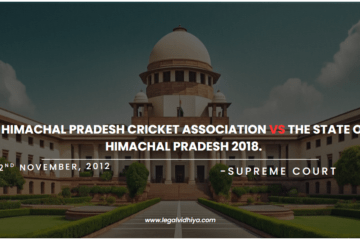
| Citation | AIR 2002 SC 1771 |
| Date of Judgment | 10th April .2002 |
| Court | Supreme Court of India |
| Case Type | Writ Petition (Civil) 509 of 1997 |
| Petitioner | Rupa Ashok Hurra |
| Respondent | Ashok Hurra |
| Petitioner’s Advocate | Kamini Jaiswal |
| Respondent’s Advocate | Abhijat P. Medh |
| Bench | S.P.Bharucha Cji , S.S.M.Quadri , U.C.Banerjee , S.N.Variava , S.V.Patil |
| Sections Referred | Constitution of India Art.32, Constitution of India Art.137 |
FACTS OF THE CASE
This is a case of matrimonial dispute where the petitioner Rupa Ashok Hurra wants to withdraw her consent for mutual divorce, despite giving her consent earlier.
According to the 1997 judgment, The respondent and petitioner got married on 3rd December 1970 as per the Hindu rites and customs at Ahmedabad. The couple had some issues and due to differences in opinion, they were not able to stay together. From 30th June 1983, the husband and wife started living separately. On 21st August 1984, a joint petition for mutual divorce was filed under section 13B of the Hindu Marriage Act,1955. In 1985, the husband alone moved the application for divorce, and a notice was issued to the wife to be present for the order. There were attempts made for reconciliation but all attempts were unsuccessful. On 27 March 1986, the wife withdrew her consent for divorce. The husband objected and stated that the wife had no right to revoke the consent which she had legally granted earlier. The objection made by the wife compelled the husband to approach the Supreme Court of India praying for divorce. On 10th March 1997, the Supreme Court allowed the special leave petition and passed a decree for divorce and such decree shall take place only after the payment of maintenance of Rs.10 lakh to the wife. The wife filed a review petition under Article 137 seeking a review of a judgment or order passed by the Supreme Court of India and the review petition was dismissed but it gave rise to an important constitutional question.
ISSUE RAISED
Whether the aggrieved person is entitled to any relief against the final judgment or order of this Court, after dismissal of the review petition, either under Article 32 of the Constitution or otherwise?
ARGUMENTS
Arguments by the petitioner
The learned senior counsel for the petitioner argued on the following points:
- They argued that the Supreme Court’s finality of decision had to be re-examined in cases where there has been a violation of the principle of natural justice, fundamental right, or order passed without jurisdiction. They further argued that the court has inherent jurisdiction and that such cases must be examined under this jurisdiction.
- Rule 6 of Supreme Court Rules is a rendition of Article 137 of the constitution which focuses on providing remedy to the injustice suffered. For its proper functioning without any conflict, such inherent power must be invoked by an application which has to be certified by a senior advocate. If there is any frivolous application then the petitioner has to bear its penalty costs.
- Article 129 of the Constitution states the supreme court is the court of record and thus it has all the powers to pass orders to undo injustice.
Lastly, they cited several cases but one of the important cases cited was Harbans Singh v. State of Uttar Pradesh and Ors 1982 (2) SCC 101 which shows even after the dismissal of the Review Petition, the Supreme Court can reconsider its judgment.
Arguments by the respondent
This is a case where the attorney-general of the court was of the opinion to give justice to the aggrieved party even being the amicus curiae (friend of the court). They stated the following arguments:
- The relief would not be available to the aggrieved party after the final order passed by the Supreme Court unless and until it is an exceptional situation where there has been a violation of the principle of natural justice, fundamental right or order passed without jurisdiction. They further stated that in order to correct the final judgment based on the aforementioned situations, a curative petition must be entertained and the bench must contain the senior judges as well as the judges who passed the order.
- The corrective power must be derived from Articles 32 and 129 to 140.
- While considering such curative petitions, the principle of stare decisis and finality and certainty of the law established by this court must be considered.
JUDGMENT
The Supreme Court held that while the Constitution of India does not confer a power of review on the Supreme Court’s judgment, the Supreme Court has an inherent power to review its own judgment under Article 137. The court emphasized that this power should be used only in exceptional cases. The judges were of the opinion that even though the judges have all the knowledge and always give their best to provide justice at the end, they all are human beings and in rarest of rare cases the final judgment might not be providing justice and thus it must be reconsidered.
The five bench judge held that in order to rectify gross miscarriage of justice in its final judgment which cannot be challenged again the court will “allow” curative petition to seek a second review of the final order of the court.
While considering such curative petitions some requirements must be fulfilled:
- Such curative petitions must not be entertained without strong reasons.
- The court barred the litigants from challenging final decisions.
- The petitioner is entitled to relief of ex debito justitiae if there is a violation of natural justice where the interested person was not a party but it affected him and if he is a party then no notice was served to him or due to negligence there is a scope of bias which affects the petitioner.
- The curative petition must have a certification by a senior advocate
- Also, it should be sent to the three senior judges and also the judge who passed the judgment.
- If the majority of the judges conclude that the matter must be heard before the same bench to pass an appropriate order.
- Exemplary costs must be levied if the plea for review lacks merit.
The court stated that it is a legal and moral obligation of the Apex Court to rectify error and thus the case was dismissed.
CONCLUSION:
This is a landmark case for the power to review its judgment under Article 137 of the Constitution. The Supreme Court through this case clarified that a review can be sought even after the final judgment. The court also outlined that the power of review must not be confused with the rehearing of the matter on merit. The case of Rupa Ashok Hurra v Ashok Hurra is significant because it clears out the scope and limitation of the Supreme Court’s power to review its own judgment and such review must be done only under exceptional circumstances.
This Article is written by Jayanti Roy of Department of Law, Calcutta University, intern at Legal Vidhiya.




0 Comments